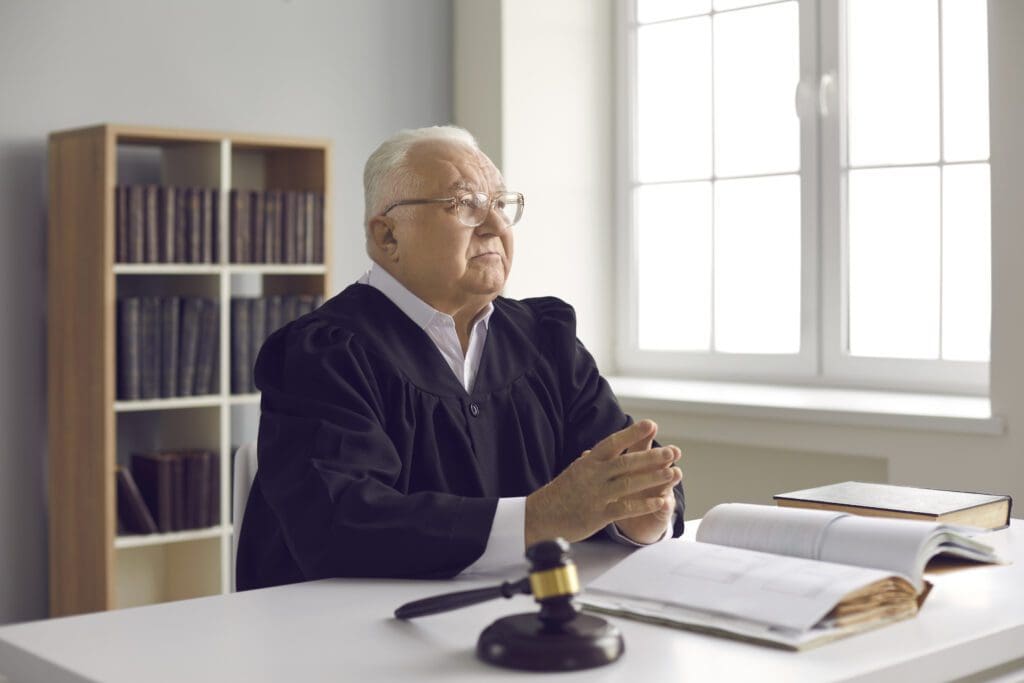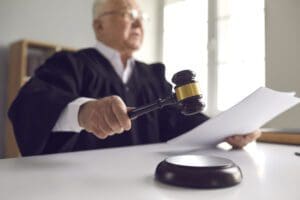A while back, I outlined the first part of a process to analyze a civil case. I wanted to see if a “one size fits all” recipe could help pro se litigants form a litigation strategy and guide our steps as we moved through our cases. The recipe ranged from identifying the court and parties to understanding the pleadings, discovery options, pre-trial and trial procedures, and possibly an appeal. In this second part, I’m going to apply that recipe to a slip-and-fall scenario to see where it takes us on litigation strategy. Here’s the scenario:
While shopping in a Hoboken warehouse store, Annette saw a table with free samples of cheese-wrapped turkey bacon in tiny paper cups. Annette loved bacon. The samples smelled great and looked even better in the pictures hanging above the table. Her stomach growling in hunger, she crossed the room to grab a sample. As she approached the table, a store employee extended his hand toward Annette with a paper cup filled with bacon. Eyes glued on the cup, she stepped on something wet and oily. In free fall, Annette grabbed the nearest display stand, which contained jars of infused olive oil and balsamic vinaigrette. The display hit the floor ahead of Annette, its glass exploding into pieces. Annette landed on her right side. She felt sharp pains as the glass tore into her right arm and hip. She bumped her head and passed out.
When the ambulance arrived, the store employee reported seeing no liquid on the floor prior to Annette’s fall. Annette had broken an arm and hip, and she had a concussion. Annette spent months healing, and her medical bills stacked up. The store refused to cover her bills or take any responsibility for her injuries. In fact, when she’d sent a demand letter seeking compensation for medical bills, the store’s owner threatened to sue her for the damaged jars of vinaigrette.
From prior experience, she knew the personal injury attorneys in her area would leave her pennies in a settlement after their “expenses” were deducted, and she felt she couldn’t do any worse using her own litigation strategy. Nearly a year after her fall, Annette filed suit pro se.
Our process for analyzing the case and developing a litigation strategy starts with identifying the proper court and journeying through the claims, defenses, discovery issues and trial. Let’s take a look.
Step I — Case Information
Annette files her slip and fall lawsuit in the Hudson County Superior Court against the sole defendant, Hoboken Wholesalers, a New Jersey corporation.
Step II — Claim(s)
Annette’s claim is simple. Hoboken Wholesalers had been negligent in allowing a spill to remain on the floor, and an employee had directed her through its path. That negligence had resulted in extensive bodily injury and medical bills. Annette learns that an essential element of a slip and fall case is that the property owner or employee should have known about the dangerous condition — and removed it — before she was injured. Her complaint asserts that the oily liquid on which she slipped had been present on the floor for several minutes. She also asserts that the employee who handed her the bacon was in a perfect position to see the spill. She believes store video and witnesses will provide the evidence she needs to carry out her litigation strategy and prove her case.
Step III — Defenses
In its defense, Hoboken Wholesalers denies all of Annette’s allegations. The company also states that Annette caused her own injuries by rushing toward the bacon so quickly that she missed seeing the liquid on the floor. That spill would have been obvious to her had she been paying attention to her surroundings. Further, the company asserts that the shoes Annette wore that day were brand new, with slippery plastic soles. Her own choice of shoes contributed to her fall. Hoboken Wholesalers will use Annette’s medical bills, which include statements about how she was injured, as evidence supporting these defenses.
Step IV — Counterclaim(s)
But the company also has claims of its own. As promised, Hoboken Wholesalers countersued Annette for damage to its display case and the products it held. The store claimed that by causing her own injuries, Annette had disrupted its operations, scared its customers away, and lowered its revenue that day. She’d made a mess of the store and destroyed $500 worth of prized vinaigrette. Store video and Annette’s own statements to medical personnel would provide the necessary evidence.
Step V — Discovery Strategy
Annette sends Hoboken Wholesalers a request for production seeking all documents and videos that have any bearing on the case. She also sends interrogatories asking for contact information on any witnesses, all employees on staff that day, and data on previous spills and customer injuries. Hoboken objects to parts of Annette’s request, asserts privilege on other parts, and serves Annette with a notice of video deposition. Annette testifies at the deposition. She collects affidavits from witnesses and store employees. As the discovery period ends, she feels she has the evidence necessary to prove her case at trial.
Step VI — Trial Strategy
Both parties move for summary judgment in the case, and both motions are denied. The court determines there are enough factual disputes to merit a trial. The parties exchange witness lists and proposed exhibits for trial. Both parties file motions to bar certain items of evidence from the trial. Except for stipulated issues, the trial court denies all pretrial motions. Annette demands a jury trial. The clerk of court calls up a jury pool, and the three-day trial begins with voir dire. The jury is impaneled and opening statements are given. Annette first calls the emergency medical technician who treated her at the store and transported her to the hospital. She calls the emergency room physician who treated her, along with several doctors and physical therapists who’d treated her since the fall. She also calls the store employee who’d handed her the cup of bacon that day. He admitted to having seen the spill when it occurred but had forgotten about it until Annette stepped in it. Annette also called a former store employee who testified that store managers often delayed spill cleanup. She told the jury several customers had been injured over the years as a result. Hoboken Wholesalers called a shoe expert who testified that new shoes with plastic soles were more likely to slip on wet surfaces than older shoes or shoes with wooden soles. The jury found the company liable for 100% of Annette’s injuries, and it awarded her more than $96,000 in actual damages. The jury also awarded $1 million in punitive damages for the intentional act of failing to clean up the spill.
Step VII — Appeal Strategy
Hoboken Wholesalers was outraged by the punitive damage award and determined to appeal the jury’s verdict. The company filed its notice of appeal 30 days after the judgment was entered. The appeals court set a deadline for the brief. In its brief, the company argued that under New Jersey’s Punitive Damages Act, slip and fall cases were not subject to punitive damages. In response, Annette agreed that no previous cases of punitive damage awards had been made in slip and fall cases.
But in her case, the jury had made a specific finding of the company’s intentional misconduct, so the $1 million sanction was appropriate and should be left undisturbed. Hoboken Wholesalers argued in reply that since no evidence of intentional misconduct had been presented at trial, the jury had no basis for finding intentional misconduct by the company. The appeals court agreed and reversed the jury’s award of punitive damages. Still, Annette was pleased with her win at trial. She would have money to pay for future medical bills stemming from the injury.
Now imagine you’re Annette, and you’re doing this analysis prior to filing suit. Would thinking through the various procedures and developing a strategy help you make better decisions during the case? Would it help you stand up to intimidation tactics from the company’s lawyer? Would it help you assert yourself when the judge advised you to get a lawyer? Would it help you refuse the lowball settlement offer the lawyer and judge tried to pressure you to accept? I think so.
Whether plaintiff or defendant, analyzing your case from beginning to end is a surefire way to recognize your options throughout the case, and that’s the first requirement of a win. It’s worth noting that this analysis works perhaps even better for defendants than for plaintiffs. Annette’s litigation strategy as a plaintiff is simply to get her case to trial with the evidence she needs to win. Other strategies may be available to defendants who want to obstruct an adverse judgment.
What do you think of our process for analyzing a case and carrying out a litigation strategy? Share your suggestions in the comments below.




I think Part 1 is only a beginning of a ‘process for analyzing a case’. A long shopping list of steps is a good start, so Part 1 is useful for that. After that, you could probably outline several scenarios or case examples – leading to a ‘set of recipes’ for how to handle specific types of cases. Just like you have abstracted in your other Recipes article. That’s a big task. A manageable task would be to break this down to case studies of ‘typical cases’ even though there are no typical cases – perhaps to break strategy down into ‘how to accomplish specific tasks’ – with suggestions of key strategies applicable to a specific problem. Problems could be for example, ‘how to deal with a judge who restricts inspection of physical evidence’, or ‘how to negotiate a lawyer attempting to limit the number of days of your deposition’, or ‘how to negotiate with a lawyer who uses an obfuscation strategy to disallow your evidence’ – etc – which are all issues we are going through now. You probably have a good idea of typical pain points of pro se’s – so perhaps go through strategies by the ‘problem type’ rather than by overall case strategy?